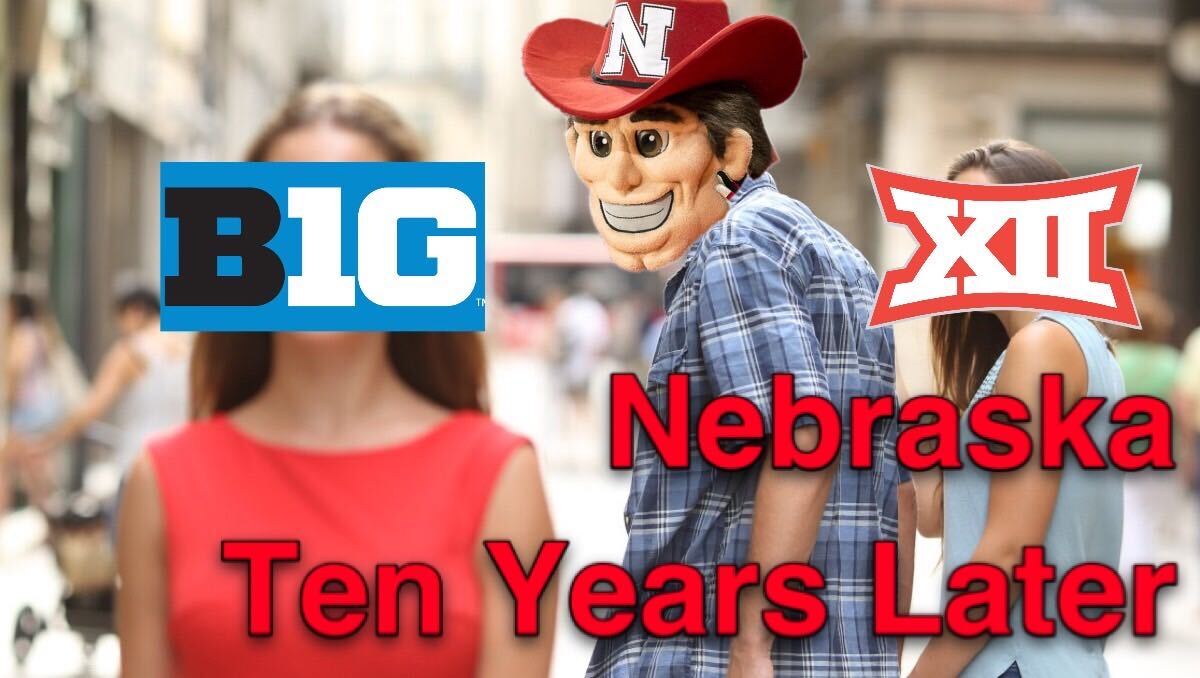It has now been ten years since Nebraska left the Big 12 Conference for the Big 10 on June 11, 2010. On that date, the Huskers made the move out of a conference they had been a core member of since 1907, when they were original members of a conference that morphed from the MVIAA to the Big 6 to the Big 8 to the Big 12. A decade is a lot of time to think and reflect. With that, it’s time to take a George Bailey-esque look back and find out: Was Nebraska bolting for the Big 10 worth it?
Nebraska held a nearly unprecedented loyalty to the Big 12. Now, only Kansas remains as core member of the conference, with Iowa State just a year behind. Kansas State joined in 1913, Oklahoma in 1919, and Oklahoma State in 1925 (the Cowboys would, however, take a little 30 year break to move to the MVC). While in the conference, Nebraska started an unrivaled sellout streak, developed unparalleled rivalries, won 46 conference titles, and 5 national championships. That doesn’t even count the 9 other national titles awarded by several media organizations that the school doesn’t officially claim in their ring of honor.
That brings us to to present day, or at least the last 10 years. Since joining the Big 10, the Huskers have appeared in one conference title game (getting boat raced by Wisconsin in 2012) and winning zero conference or national championships. They have lost five of their last seven bowl games and completely missed the postseason in each of the past three years. They have won 75 games in total in that time span, with Bo Pelini being responsible for 47 (63%) of those victories.
So was the move to the Big 10 worth it? Worth is a tricky target, but, by nearly every measure, the move was necessary.
In the Big 12, there was the Texas problem. The Longhorns, with their self-importance at an all-time high, started the Longhorn Network, which brought them an influx of cash and the rest of the conference a “sorry not sorry” type of note. That move forced Nebraska and Colorado to take a harder look at the door, with Texas A&M soon to follow. While the old guard amongst us continue to tout the purity of collegiate athletics, the reality of the situation ultimately comes down to money.
Without the influx of cash the football program brings other sports are not as likely, or possible. In 2018, the Big 10 made $759 million in revenue, more than any other conference. That figure is nearly $100 million more than the SEC and double the Big 12. It’s easy to focus on football. I certainly do, but that influx of cash affords the university more opportunities as a whole. They can pay for better coaches, fund better facilities, and support non-revenue generating sports at a much higher capacity.
In short, the money alone is enough to deem Nebraska’s move a success.
Now, I would obviously love to see Nebraska football in a real title hunt again, be it for the Big 10 title or the College Football Playoff. Realistically, though, the Huskers are a long ways off, certainly behind Wisconsin and, truth be told, Iowa in that regard. Will Scott Frost get them back to being a player in the Big 10 West? The support system is in place for him and, by extension, Nebraska to succeed. Whether or not he will is, at this point, up in the air.
In hindsight, the path was undoubtedly easier in the Big 12. When Nebraska left the conference, they were an upper-echelon team in the conference, losing narrowly to Oklahoma and Texas respectfully in the conference title game in 2009 and 2010. After all, the only team to actually make the College Football Playoff from the Big 12 has been Oklahoma. If you’re able to run the table or put together a magical season here or there, the Big 10 currently seems to carry more cache with the CFP selection committee.
No Husker fan would argue that the move to the Big 10 has resulted in the success that the program and its supporters expect. Let’s just say that getting beat by Purdue and Minnesota was not on the bucket list. Success on the field is one metric (an important one, no doubt), but it’s also shortsighted. The Big 10 is, quite simply, in a position that almost no other conference can match financially.
The road to the promised land, though, is wrought with Badgers, Buckeyes, and Nittany Lions. Someday, hopefully sooner rather than later, seeing those teams on the schedule will produce excitement at the possibility of victory and the chance to truly make new and lasting rivalries.

